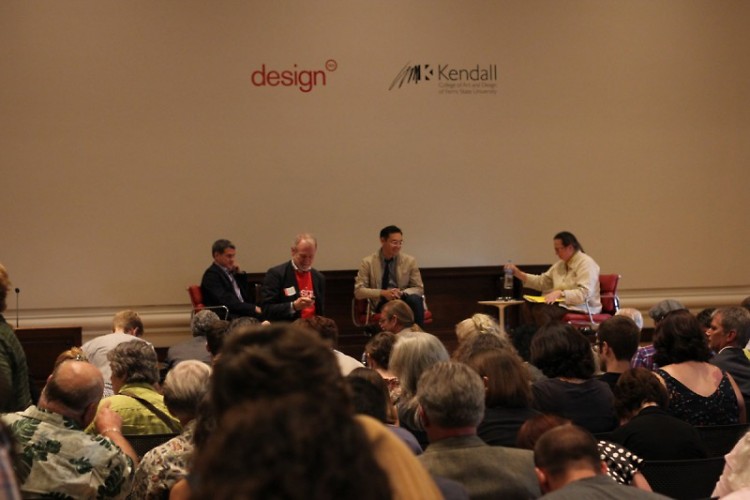Thursday night at Kendall's newly rennovated Federal Building, Design West Michigan hosted a panel discussion with Andrew Blauvelt and Joseph Rosa, with Susan Szenasy moderating. The topic was “The Difference Between Art and Design” and a little bit of what they discussed was on topic, the rest was tangentially related. They arrived on the topic of architecture as art and stayed there.
We normally think of architecture as design, but design involves working with a client and creating a product that is functional for them. If architecture is functioning only as an expression of what the architect wants, it ceases to be design and becomes something closer to a commissioned piece of art. This led the conversation to museum design, where it stayed for a great portion of the talk. They discussed the value of landmark art museums, buildings that function as attractions unto themselves, let alone the art inside. The downside of this type of building is that often, they are ineffective at actually displaying art. There should be some balance that can be achieved between the two, a building by a big-name architect that still achieves the desired function, but that balance is hard to find. They also touched on the topic of art museums that involve modern additions to older buildings, which would have been interesting to elaborate on, and would have tied in nicely with the recent renovations of the Federal Building.
This discussion, while intriguing, would have been much better suited to a panel about architecture as art than a panel about the difference between art and design. In fact, the first question from the audience was “What is the difference between art and design?” which earned a few laughs. In his answer, Blauvelt touched on something that I wish everyone had talked about more, the fact that context matters. If you put an Eames LCW on a pedestal in a museum, does it inch closer to becoming art? If it's inching toward art, does it move away from design, or can it exist in both spheres? If someone who was trained only in design starts to create designs for which there is no client, is that art? Are commissioned artworks somewhat like design?
Why does the difference between art and design even matter? I think one of the people on the panel mentioned this, but it wasn't discussed much. I don't think that there needs to be a defined rule or a line between the two, and I think that trying to keep them separate is counterproductive and discourages collaboration. I wish that question, the supposed topic of the panel had been discussed more, because I think that they would have come to a similar conclusion, that the difference between art and design is not really something that we should care about.
Overall, the event could have been coordinated better. The venue wasn't made for this sort of thing, and there were some issues with the sound system. From what I overheard, there was space for 300 people, but 400 attended. That meant that many people were watching on tv screens from the lobby of the Federal Building or from Kendall's main building. For future events, I think that Design West Michigan should try to find a larger venue, and see what can be done about the sound situation.
The Rapidian, a program of the 501(c)3 nonprofit Community Media Center, relies on the community’s support to help cover the cost of training reporters and publishing content.
We need your help.
If each of our readers and content creators who values this community platform help support its creation and maintenance, The Rapidian can continue to educate and facilitate a conversation around issues for years to come.
Please support The Rapidian and make a contribution today.
